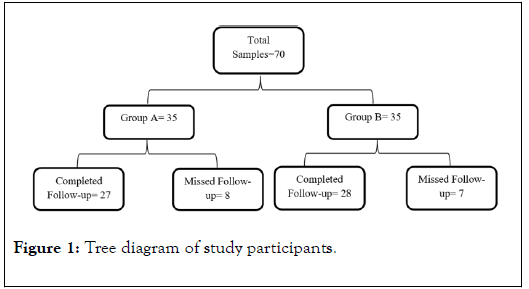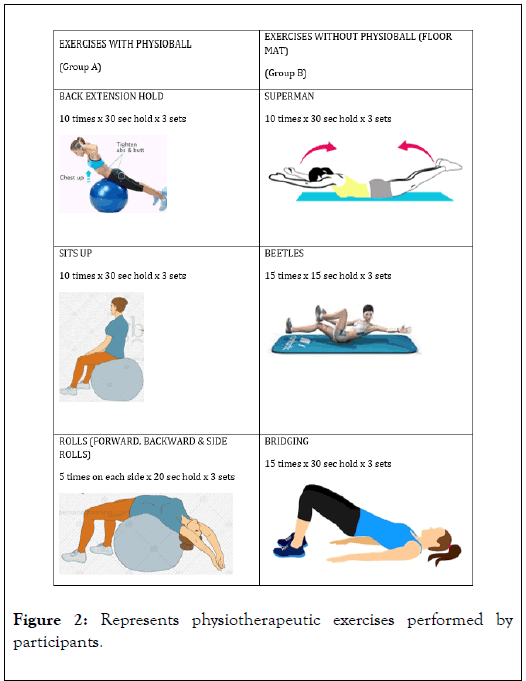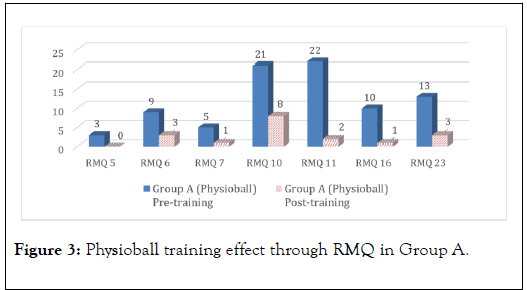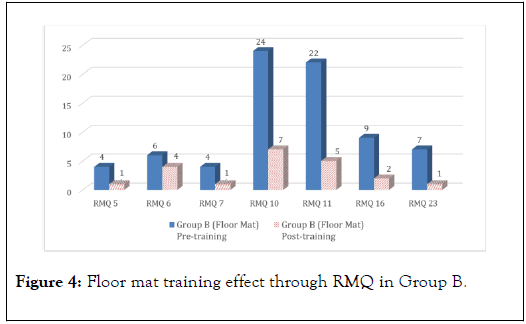International Journal of Physical Medicine & Rehabilitation
Open Access
ISSN: 2329-9096
ISSN: 2329-9096
Research Article - (2020)Volume 8, Issue 5
Objective: To compare the effectiveness of core stability exercises with and without Physioball in chronic low back pain and functional ability in young female students of a private medical college.
Methodology: A quasi-experimental study with non-probability convenience sampling technique from March 2019 to January 2020 carried out at Bahria University College of Physical Therapy Karachi. Inclusion was female with history of chronic mechanical and postural backache for more than 12 weeks, age 18-22 years. Exclusion criteria were those on pain killer medications for backache or having pathological back ache. Participants were divided into two groups. Group A were given core stability exercises with Physioball, which include back extension hold, sit ups and forward backward and side rolls. Group B were given core stability exercises without Physioball (Floor Mat), including superman, beetles and bridging. Three sessions per week for 6 weeks once in a day followed by warm up and cool down exercises. Pre and Post assessments through Visual Analogue Scale and The Roland-Morris Low Back Pain and Disability Questionnaire
Results: A total of 70 participants were included. Mean pre-assessment of group A was 4.70 ± 0.91 and postassessment was 0.96 ± 0.52 with significant p value of<0.0001. Group B pre-assessment mean score was 5.32 ± 1.52 and post-assessment mean score was 1.36 ± 0.87 with significant p value of <0.001. Group B participants showed improvement in trunk stability and balance control whereas group A observed better results.
Conclusion: Core stability exercises with Physioball showed better pain management, trunk control and balance as compared with floor mat exercises.
Core strength training; Low back stability exercises; Endurance training
The core can be expressed as a pattern of muscle arrangement in a box with the abdominal muscles in front, paraspinals and gluteal in the back, base by pelvic floor and hip girdle and top of the box formed by the diaphragm [1]. Twenty-nine groups of muscles form core box which helps to stabilize the spine and pelvic which also helps in kinetic chain during functional movements. Without or with weak core muscles the spine would be mechanically weak and compressive forces can make it worse [2]. All these muscles have direct or indirect attachments to the extensive thoracolumbar fascia and spinal column, which connects the upper body and lower limbs. A comprehensive strengthen or expedition of these core muscles has been encouraged to preclude and reeducate various lumbar spine and musculoskeletal disorders [3].
Core stability has become a well-known development synonym that has started in the world of sports rehabilitation and fitness programs including Pilates, Yoga and Thi chi which follow core strengthening principles [4]. From Stability of spine, mobility of spine to weight transfer and mechanical stress, all depends upon core stability. Core training emphasizes strength and conditioning of local and generalized muscles that stabilizes the spine [5]. Now a day’s Specific training of muscles around the lumbar spine focuses on physical therapy management of patient with chronic low back pain [6].
Low backache is a pain or discomfort in lumbar spine due to mechanical or non-mechanical origin involving muscles, ligaments, nerves, disc and bone of lumbar spine. Pain for more than 12 weeks is considered as chronic pain. Poor posture, heavy backpack, diet, sedentary life style all play important role in developing chronic low back pain [7]. Recent focus in physiotherapy management of patients with chronic low back pain has been specific training of dynamic stability and segmental control of spinal muscles with core stability exercises by using different core stability protocol.
Low back pain whether acute or chronic is becoming an extensive cause of restricted mobility in lumber spine throughout the world and effects almost 85% of general population [8]. Now a days chronic low back pain is not only common in elders or sports person but also common in young adults.
The term “ Physioball ” was originated as earliest use of an exercise ball during 1965 in Switzerland where a group of physical therapists used it in their research work with cerebral palsy children. It is also known as stability ball, fit ball, yoga ball or swissball. Physioball can be used in variety of fitness training program including strength, endurance, balance, flexibility and more importantly core stability [9]. Due to its structure it challenges core muscles of an individual while performing strengthening exercises. The body responds naturally to this instability to keep balanced on the exercise ball. Over time, the muscles used to keep in balance on the Physioball become stronger. Individuals build their strength in important back muscle and abdominal muscles without knowing it [10].
All movement are initiated at the gravitational center in lumbopelvic region. During performing different exercises on Physioball center of gravity remains unstable and constantly shifts. The group of muscles surrounding the body center point, plays a key role in maintaining stable base of support, generally known as the Core Muscles. These are the major muscles responsible to keep up our static and dynamic postures and movements [11]. These core muscles act as a bridge between upper and lower extremities in force transference. Other than balancing one of the important functions of the core muscles is to cover the passive structures and helps in protection and support the spine. Previously core strengthening exercises were majorly used for prevention only but now they are widely used in sports medicine community and rehabilitation programs [12].
Principles of core training are divided into three stages core stabilization, core strengthening, core power respectively. The benefits of good core training program will decrease the chance of back and neck pain, incontinence, rupture discs, muscles and ligamentous strain and many other orthopedic injuries. Our body is design to work at most economic levels in terms of energy consumption therefore weak core muscles tends to require more energy in maintaining misalign posture thus causing joint pain [13].
We can explain that the trunk is a kinetic chain which connects the whole body. The problem or weakness in one part can also cause the pain or injury in other part of the body. In short, core is an integrated functional unit consisting of lumbo-pelvic-hip complex and thoracic and cervical spine, works collectively to balance and support the body [14].
This was a quasi-experimental study with non-probability convenience sampling technique. The study duration was from March 2019 to January 2020 carried out at Bahria University College of Physical Therapy Karachi. Sample size was estimated from the software G Power version 3.0.9.2 by taking the statistical conditions of 95% confidence interval, 5% margin of error and two proportion independent group estimation technique. The required sample size derived from the software was 70. Total 70 samples were divided into two equal groups. Physioball Exercises were given to Group “ A ” and without Physioball (floor mat) exercises were given to Group “B”. The inclusion criteria consist of female Students of BUCPT with history of chronic backache for more than 12 weeks, those who gave consent, having age in between 18-22 years, healthy range of BMI (18-22.9 kg/m2) and having mechanical and postural back ache. Exclusion criteria included BMI less than 18 or greater than 22.9 kg/m2, those who have been taking pain killer medicines for backache or having pathological back ache (eg, infection, tumor, osteoporosis, lumbar spine fracture, structural deformity, inflammatory disorder, radicular syndrome, or cauda equina syndrome). The assessment tools for pain and disability were Visual Analogue Scale (VAS) and The Roland-Morris Low Back Pain and Disability Questionnaire (RMQ). The subjects of Group A were given core stability exercises with Physioball, which include back extension hold, sit ups and forward backward and side rolls. Group B of 35 subjects were given core stability exercises without Physioball, including superman, beetles and bridging. Both groups were given three sessions per week for 6 weeks once a day followed by warm up and cool down exercises. Pre and Post VAS score and RMQ score were recorded.
Statistical analysis was done on SPSS version 23.0. Frequency and percentages were calculated for all categorical variables. Bar chart was made for different variables. To see the significance between groups pre andpost assessment paired sample t-test was applied. Independent sample t-test was used where significance between two groups were done. p value ≤ 0.05 considered to be statistically significant (Figures 1 and 2).

Figure 1. Tree diagram of study participants.

Figure 2. Represents physiotherapeutic exercises performed by
participants.
A total of 70 chronic mechanical and postural low backache participants randomized in two groups, 35 participants in group A (Physioball exercises) and 35 participants in group B (floor mat exercises). There were some participants who did not come for Post-assessment. In group A 8 and in group B 7 participants missed follow-up.
Mean age of the participants was 19.16 ± 0.86 years. In group A there were 26 participants with normal BMI and in group B 29 participant had normal BMI. Underweight and overweight participants were also observed in this study. Participants’ pain status was observed with VAS scale. The pre-assessment of group A presented none of participant with no pain, 3 (8.6%) with mild pain, 24 (68.6%) with moderate pain and 8 (22.9%) with severe pain (Figure 3). The pre-assessment of group B presented none of the participant with no pain, 3 (8.6%) with mild pain, 18 (51.4%) with moderate pain and 14 (40%) with severe pain (Figure 4). After core stability exercises with and without Physioball results showed improvement in chronic back ache. In group A post-assessment analysis observed no pain in 24 (88.9%), mild pain in 3 (11.1%) and none of the participants with moderate and severe pain. Group B 15(53.6%) with no pain, 13 (46.4%) with mild pain and no respondents with moderate and severe pain (Table 1).

Figure 3. Physioball training effect through RMQ in Group A.

Figure 4. Floor mat training effect through RMQ in Group B.
| Pre-Assessment (VAS) | Group A (Physio ball) n=35 | Group B (Floor Mat) n=35 | p value | Post-Assessment (VAS) | Group A (Physio ball) n=27 | Group B (Floor Mat) n=28 | p value |
|---|---|---|---|---|---|---|---|
| No Pain | 0 | 0 | 0.287 | No Pain | 24 | 15 | 0.004 |
| 0.00% | 0.00% | 88.90% | 53.60% | ||||
| Mild | 3 | 3 | Mild | 3 | 13 | ||
| 8.60% | 8.60% | 11.10% | 46.40% | ||||
| Moderate | 24 | 18 | Moderate | 0 | 0 | ||
| 68.60% | 51.40% | 0.00% | 0.00% | ||||
| Severe | 8 | 14 | Severe | 0 | 0 | ||
| 22.90% | 40.00% | 0.00% | 0.00% |
Table 1: Represents intensity of pain through VAS.
The VAS assessment was also analyzed with continuous measurement scale. Mean pre-assessment of group A showed 4.70 ± 0.91 and post-assessment of the same individuals observed with mean score of 0.96 ± 0.52 with significant p value of<0.0001. Hence mean of group B pre-assessment result showed 5.32 ± 1.52 and post-assessment of the same individual observed with mean of 1.36 ± 0.87 with significant p<0.001 (Table 2).
| Group A (Physioball) | Mean | Std. Deviation | Mean Difference (95% Confidence Interval) | p value |
|---|---|---|---|---|
| Pre-Assessment | 4.7 | 0.91 | 3.74 (3.4 to 4.08) | 0 |
| Post-Assessment | 0.96 | 0.52 | ||
| Group B (Floor Mat) | Mean | Std. Deviation | Mean Difference (95% Confidence Interval) | p value |
| Pre-Assessment | 5.32 | 1.52 | 3.96 (3.5 to 4.4) | 0 |
| Post-Assessment | 1.36 | 0.87 |
Table 2: Represents comparison of pre and post assessment through VAS.
The results were also analyzed through RMQ questionnaire. Effect of Physioball (Group A) and floor mat exercises (Group B) on balance and stability of trunk were observed.
Functional disability questions were selected from RMQ. According to test results the effects of Physioball exercises on trunk stability and balance were found to be improved efficiently. (RMQ 10) 21 participants in pre-assessment mentioned complain of pain during stand up for short periods of time. After treatment with Physioball 13 participants showed improvement in pain and balance. Similarly (RMQ 11), 22 participants were not able to bend or kneel down because of low stability of back in pre-assessment. Improvement is shown in 20 of the participants after Physioball exercises.
*RMQ5=Because of my back, I use a handrail to get upstairs.
*RMQ6=Because of my back, I lie down to rest more often.
*RMQ7=Because of my back, I have to hold on to something to get out of an easy chair.
*RMQ10=I only stand up for short periods of time because of my back.
*RMQ11=Because of my back, I try not to bend or kneel down.
*RMQ16=I have trouble putting on my socks (or stockings) because of the pain in my back.
*RMQ23=Because of my back, I go upstairs more slowly than usual.
*RMQ5=Because of my back, I use a handrail to get upstairs.
*RMQ6=Because of my back, I lie down to rest more often.
*RMQ7=Because of my back, I have to hold on to something to get out of an easy chair.
*RMQ10=I only stand up for short periods of time because of my back.
*RMQ11=Because of my back, I try not to bend or kneel down.
*RMQ16=I have trouble putting on my socks (or stockings) because of the pain in my back.
*RMQ23=Because of my back, I go upstairs more slowly than usual.
This study indicates the effects of Physioball and Floor mat exercises in term of relief in backache and improved functional abilities. Study was accompanied to evaluate the effects of core stability exercises with and without Physioball in low back pain participants. Literature showed that conservative exercise protocol for the pain of low back was conventional exercise alone or with other physio-devices or equipment benefited to decreases pain.
Vera-Gracia et al. [15] conducted study in which result showed that pain of low back was reduced up to 21% with use of Physioball while in present study the moderate pain was observed in 24 participants which reduced to none after postassessment in group A.
In current study the pain was measured through VAS in pre and post assessment. p value was found statically significant in both groups which were˂0.001. In comparison with a study done by Sinho Chung et al. [16] in 2013 reported that pain was also measured through VAS and the P value was found˂0.005 in both groups which was statistically significant.
In present study pre assessment of group A mean VAS score was found to be 4.74 ± 0.92 and in group B it was 5.20 ± 1.43 with significant p value of 0.019. In post assessment of group, A mean VAS score was found to be 0.96 ± 0.52 and in group B it was 1.36 ± 0.87 with significant p value of 0.000. This indicates group A participant showed more improvement. This study reveals that core strengthening done with physio-ball have good results in core muscle strengthening and improving back pain. In comparison with study done by Rajan et al. [17] showed mean value for core stability Exercises of group performing with physio ball, pre-assessment VAS was 3.80 and post assessment VAS shows improvement of value being 2.267 with p value was <0.05. This was a significant change in VAS score.
In our study significant difference were noted in pain level and strength of muscles whereas a study done Cosio Lima etal. [18] stated contrast results that there was no significant difference were noted in both groups that is with and without physio ball.
Present study result was noted pain was reduced more in participants who done exercises on physio-ball. Scott et al. [19] study showed that exercises on Physioball were more effective than on stable surfaces (floor mat)
In present study floor mat exercises were found effective in reducing VAS score with significant p value of <0.0001 as in Yoon et al. [20] showed patients with chronic low back pain in floor exercises group displayed significant decrease in VAS as compared to conservative treatment group.
In this study effect of Physioball and floor mat exercises on balance and stability of trunk were evaluated. According to the results the effect of Physioball exercises were found to be improved in terms of stability and balance. Similar result showed by O’ Sullivan et al. [21] reported that effects of lumber stabilization exercises, special exercises concerning the stability of trunk are effective in improving chronic backache and daily functions of the patients. Physioball is used for lumber stabilization exercises and improving muscle strength, endurance, balance and flexibility of the trunk along with reflexes, cognitive sense, balance and proprioceptive sense.
In present study, core strengthening exercises found to be more effective in reducing pain and improving stability and balance in trunk. Similar results reported by Wang et al. [22] compared core stability exercises with general exercises in patient with chronic backache and functional limitation and concluded that core stability exercises are more effective in improving pain and functional limitation as compared to general exercises.
Core stability exercises with Physioball showed better pain management, trunk control and balance as compared with floor mat exercises.
Acknowledgement: We are thankful to Dr. Ayesha Afiridi and Dr. Shaista Hayat for supporting in training session during the study.
Target population of only female, Subjects participated in this study has no prior gym experience, Subject participated has no prior experience of doing exercises on physioball and Only quantitative measurements are used and separate measures are used to evaluate compressive loading on spine during exercises.
Long term exercises on Physioball showed improvement in backache as well as better functional improvement. As practicing more on Physioball enhance better motor control, coordination and balance.
The authors declared that there is no conflict between the authors.
Citation: Aziz K, Shahid G, Arif A, Fahim MF, Khan R (2020) Effectiveness of Core Stability Exercises with and without Physioball on Chronic Low Back Ache in Young Females: A Quasi-Experimental Study.Int J Phys Med Rehabil.8:565. DOI:10.35248/2329-9096.20.08.565
Received: 06-Aug-2020 Accepted: 13-Aug-2020 Published: 27-Aug-2020 , DOI: 10.35248/2329-9096.20.08.565
Copyright: © 2020 Aziz K, et al. This is an open-access article distributed under the terms of the Creative Commons Attribution License, which permits unrestricted use, distribution, and reproduction in any medium, provided the original author and source are credited.